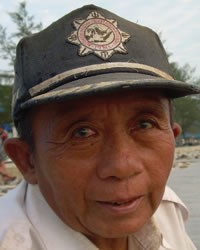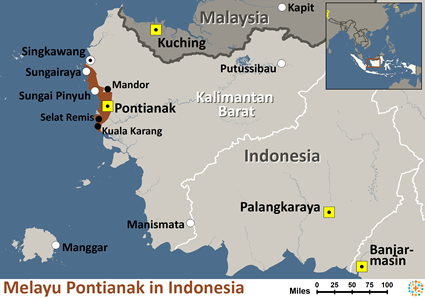The Pontianak Malay live in Pontianak Regency of West Kalimantan. Pontianak Regency is the area of Tepok Pakedai, the Kakap River, the Pinyuh River, Siantan, Mempawah Hilir, the Kunyit River and Tujuh Belas. In their area, the Pontianak Malay live alongside Chinese and Madurese people. In a few places, the Pontianak Malay also live alongside Sambas Malay people.
The Pontianak Malay speak a dialect of Malay which cannot be easily understood by neighboring peoples such as the Sambas Malay, even though they also speak Malay languages. The city of Pontianak became the center of the Pontianak Malay Kingdom, which was founded under the reign of Sultan Syarif Abdurachman Alkadrie on October 23, 1771.
The Pontianak Malay are an agrarian people whose livelihoods depend on the yield of crops from their farmland as well as harvesting freshwater and saltwater fish. They cultivate rice, coconuts and rubber. Some Pontianak Malay also work as civil servants or merchants.
The land where the Pontianak Malay live consists of swampy lowlands only 0-100 meters above sea level. This makes it difficult for them to obtain clean water. Despite this, Pontianak is a relatively developed area. According to some, however, development in the area has been slowed by the fact that there is only one road from Pontianak by which one can reach other parts of West Kalimantan. As a result, the city of Pontianak does not operate as an economic center for West Kalimantan. Even though the infrastructure of the city is better, its level of economic development is lower than other areas.
The Pontianak Malay have a bilateral system of kinship, which means that one's ancestry is traced by descent on both the father's side and the mother's side. After getting married, a new couple usually lives with the woman's parents until the birth of the first child. After this, they live in their own home. A Pontianak Malay settlement is called a kampung. Generally, Pontianak Malay houses are built on stilts two meters high to protect the inhabitants from wild animals.
Traditional clothing for men is called teluk belanda, which consists of a loose pair of pants called slawar, fashioned from woven silk cloth that covers from the waist to the knees and a rimless cap called kopiah. Women traditionally wear a long blouse called a kebaya and a long silk skirt embroidered with gold thread.
The Pontianak Malay are devout Muslims. Their art forms and culture are heavily influenced by Islamic culture. However, they still hold superstitious and animistic beliefs. This is evident in local rituals that blend Islamic culture with animistic elements. The Pontianak Malay perform these rituals to mark births, weddings, funerals, work in the rice fields, constructions of new homes and other events.
Shamans are still very influential in the local system for treating illnesses and are consulted for advice on many subjects such as marriage plans, planting fields, or choosing names for children. According to legend, the Pontianak Malay area is haunted by the ghost of a woman who died in childbirth.
One of the greatest needs of the Pontianak Malay is better transportation access. Accessibility issues have caused the Pontianak Malay to lag behind other Malay peoples in Southeast Asia in terms of education, industry and standard of living.
Pray for Pontianak Malay elders to welcome persons of peace to take Christ to their families and villages.
Pray for them to have the spiritual hunger it takes to stand for Jesus Christ no matter what the cost.
Pray for Pontianak Malay disciplers who will make more disciples.
Scripture Prayers for the Malay, Pontianak in Indonesia.
IPN, 2011 Copyrighted © Used with permission
| Profile Source: Joshua Project |

























